
In June 2018, Egon Zehnder welcomed guest speaker Greg Pryor to the Firm’s conference in San Francisco. Egon Zehnder’s Benito Cachinero interviewed Greg, who is SVP, People and Performance Evangelist at Workday, a leading provider of enterprise cloud applications for finance and HR with approximately 10,200 employees.
Benito Cachinero: A lot of people tend to think of everyone being born into this Silicon Valley microcosm, but you spent half of your career in financial companies and Accenture, living on the East Coast. Is that as dramatic of a difference as people think it is?
Greg Pryor: I would say I had to go through a detox process honestly. Coming from the East Coast and working in financial services, the first thing I was able to do was throw away all my ties. I mean, in our office, golf shirts are about as formal as we will get. So coming from New York City hard core financial services, I had to really unwind a lot. Someone once gave me that perspective that it’s much more organic, it’s lots of sharing.
B.C.: I know the idea of performance enablement is important for you. What does that mean?
G.P.: I think agility is so central to our business; the ability to flex, the ability to take on new technology and to be consumers of new technology, to be always innovating. What we’ve done is taken the essence of our culture and shifted to something that we called performance enablement instead of performance management. Performance management, to me, feels very industrial age. We asked ‘what would we do if our goal was to enable everyone’s performance instead of manage their performance?’ and that unlocked a whole new and different set of things that were true for us, and just put us in a completely different mindset. We operate within what we call ‘freedom within a framework’. We want each business, each geography, each team, each gender to have global consistency as a company that’s consistent with their culture, but also has the agility and the flexibility needed for the business.
B.C.: We often talk about “insecure overachievers.” How do you deal with them?
G.P.: Welcome to Silicon Valley. That’s what we all are. It is the nature of Silicon Valley that only the paranoid survive. That is what Silicon Valley is based on. I think it’s a balance. I was talking to one of our prospects recently who said to me, ‘I know more about my Uber driver than I do about my employees’. For those of you who are on Uber, you can see what languages they speak, how many rides they have had and the satisfaction of others. Since the vast majority of our people want the feedback I think we’re going to see more and more of these feedback mechanisms. They have to be done thoughtfully; you have to manage the unintended consequences.
“What we do know from the research is that is that collective intelligence is based on the number of women in a group.”
Greg Pryor, SVP, People and Performance Evangelist, Workday
B.C.: What challenges do you see with feedback?
G.P.: I’m a fan of Tammy Erickson’s work at the London Business School around generations in the workplace. It’s her suggestion that the psychological narrative of Millennials is the failure of institutions, and that instead, it’s overwhelmingly about feedback. They entered the workforce during the recession and they watched all of their colleagues get picked off, one by one, and the group that survived was those with the greatest skills, with the greatest agility and diversity. They had accumulated the greatest flexibility. Erickson believes that the narrative of our millennial population is optionality.
B.C.: What’s a good archetype that creates social capital and cohesion? Is it just being an extrovert?
G.P.: Extrovert or introvert does not matter. It doesn’t matter at all. What we do know from the research is that is that collective intelligence is based on the number of women in a group. A group is smarter when it has more women in it. The reason we know this is actually because women have a tendency to provide more turn-taking, and that they encourage and invite people into conversations as opposed to pushing their ideas. They pull other people into the network as opposed to pushing them into the network.
B.C.: How do you connect talent to business outcomes?
G.P.: Workday’s number one principle is that happy employees equal happy customers. So our fundamental objective is that we are there to enable our talent to solve perhaps the most difficult technology challenges on the planet today. And so we need to have the right people, be able to attract those right people, and give them the psychological safety required to enable them to do their best work. From an innovation perspective, we need to make sure we have created an environment where people have the creativity to solve some of the most challenging technological issues out there. This is fundamental to our relationship with our customers.
B.C.: How does Workday’s culture translate into your customer base? Do you see the product affecting the end user?
G.P.: 50% of the innovation in our product comes from our customers. I think a lot of that comes from the humility of our people and again, it’s sort of the fundamental culture that we stay open. I spend a lot of time with our customers. I want to be the first to go out and say ‘what are you discovering, what are the things, what are the challenges you have?’ I have learned from every one of those customers and then go back and spend time back with our products.
B.C.: How often do you recruit leaders from the outside? How do you ensure that someone who hasn’t lived in your ecosystem can integrate well into all of this?
G.P.: We wanted to bring people in slightly smaller jobs to test them out from a cultural perspective. For us, it’s really important that those people practice humility but that they have the attributes and that we give them coaching and feedback very early on. We’re about I would say 40% outside, 60% inside to date. Given our growth trajectories, I would expect that to probably shift a little bit more to the outside. Our succession at the highest levels has come from inside, and we probably could continue to do a better job of bringing new people in because culture is so important to us and it’s sometimes hard to read the tea leaves of our culture.
B.C.: You seem to be very well-connected to different educational institutions. Do you do anything to cultivate and nurture this kind of talent before they join your company?
G.P.: A very intentional part of our recruiting strategy is to actually build communities ahead of time to be engaging, and connecting with people. About 67% of our workmates have referred someone who has been employed at the company within the last year. So we have a very, very high employee referral rate. It’s very hard for us because we try to avoid recruiting from our customers. That’s becoming increasingly hard especially here in Silicon Valley, since most of the companies are our customers. So nurturing those relationships upfront and creating those sorts of networks is increasingly important, but it’s super hard.
"Our culture is our ‘secret sauce’ because it facilitates innovation and it facilitates customer relationships. You get those two things wrong, it’s over. ”
Greg Pryor, SVP, People and Performance Evangelist, Workday
B.C.: What about acquisitions? How important is the cultural fit when you acquire, and how do you assess it?
G.P.: I would say it’s the most important thing. I mean, it’s where we started. Our culture is our ‘secret sauce’ because it facilitates innovation and it facilitates customer relationships. You get those two things wrong, it’s over. We are building a new very large building in Pleasanton and I toured our building recently. I’m with a construction guy and he keeps turning and said ‘we did this because we knew your workmates would love this.’ How is that possible? That’s what we refer to our colleagues as, workmates. So it’s a fact that our culture becomes so pervasive that even the folks who are doing contracting in our building know and talk and discuss in our terms.






